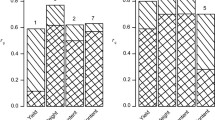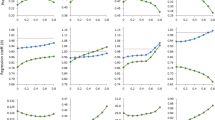Abstract
Best Linear Unbiased Prediction (BLUP) has become the most widely used method for genetic assessment of animal and perennial species, and it is potentially relevant for annual crops. The objective of this study was to assess this method for selection within non-inbred families in recurrent breeding programs. The ‘animal model’ was fitted. The data were expansion volume (EV) and grain yield of plants in recombination plots of two to three selection cycles in the popcorn population Viçosa, with half- and full-sib progenies. The ASReml program was used to perform the analyses. For both EV and yield the breeding values predicted from the additive and additive-dominant models were highly correlated. Multi-generation BLUP was, in general, more accurate than single-generation analysis. These two methods resulted in highly correlated predicted breeding values. The dominance genetic values predicted from the single- and multi-generation analysis were also highly correlated. The pedigree information reduced the percentage of coincidences among the selected individuals relative to phenotypic selection mainly in the population structured in half-sib families. Based on breeding values predicted by BLUP analysis, the most efficient selection procedure was mass selection.
Similar content being viewed by others
References
Bauer AM, Léon J (2008) Multiple-trait breeding values for parental selection in self-pollinating crops. Theor Appl Genet 116:235–242
Bauer AM, Reetz TC, Léon J (2006) Estimation of breeding values of inbred lines using best linear unbiased prediction (BLUP) and genetic similarities. Crop Sci 46:2685–2691
Bernardo R (1996) Best linear unbiased prediction maize single-cross performance. Crop Sci 36:50–56
Cantet RJC, Birchmeier AN, Santos-Cristal MG, de Avila VS (2000) Comparison of restricted maximum likelihood and Method R for estimating heritability and predicting breeding value under selection. J Anim Sci 78:2554–2560
Crossa J, Burgueno J, Cornelius PL, McLaren G, Trethowan R, Krishnamachari A (2006) Modeling genotype x environment interaction using additive genetic covariances of relatives for predicting breeding values of wheat genotypes. Crop Sci 46:1722–1733
Cullis BR, Smith AB, Coombes NE (2006) On the design of early generation variety trials with correlated data. J Agric Biol Environ Stat 11:381–393
Eberhart SA (1970) Factors effecting efficiencies of breeding methods. Afr Soils 15:669–680
Flachenecker C, Frisch M, Falke KC, Melchinger AE (2006a) Modified full-sib selection and best linear unbiased prediction of progeny performance in a European F2 maize population. Plant Breed 125:248–253
Flachenecker C, Frisch M, Falke KC, Melchinger AE (2006b) Trends in population parameters and best linear unbiased prediction of progeny performance in a European F2 maize population under modified recurrent full-sib selection. Theor Appl Genet 112:483–491
Gilmour AR, Gogel BJ, Cullis BR, Thompson R (2006) ASReml user guide release 2.0. VSN International Ltd, Hemel Hempstead
Henderson CR (1974) General flexibility of linear model techniques for sire evaluation. J Dairy Sci 57:963–972
Knott SA, Sibly RM, Smith RH, Moller H (1995) Maximum likelihood estimation of genetic parameters in life-history studies using the “animal model”. Funct Ecol 9:122–126
Kruuk LEB (2004) Estimating genetic parameters in natural populations using the “animal model”. Philos Trans R Soc Lond B Biol Sci 359:873–890
Kumar A, Gandh RS, Singh A, Haile A (2008) Comparison of animal model with other conventional methods of sire evaluation for milk production in Karan Fries cattle. Indian J Anim Sci 78:1393–1396
Leclerc H, Wensch-Dorendorf M, Wensch J, Ducrocq V, Swalve HH (2008) A general method to validate breeding value prediction software. J Dairy Sci 91:3179–3183
Littell RC, Milliken GA, Stroup WW, Wolfinger RD, Schabenberger O (2006) SAS for mixed models, 2nd edn. SAS Institute Inc., Cary
Matta FP, Viana JMS (2003) Eficiências relativas dos processos de seleção entre e dentro de famílias de meiosirmãos em população de milho-pipoca. Ciência e Agrotecnologia 27:548–556
Mrode RA (2005) Linear models for the prediction of animal breeding values, 2nd edn. CABI Publishing, Oxfordshire
Nunes JAR, Ramalho MAP, Ferreira DF (2008) Inclusion of genetic relationship information in the pedigree selection method using mixed models. Genet Mol Biol 31:73–78
Patterson HD, Thompson R (1971) Recovery of inter-block information when block sizes are unequal. Biometrika 58:545–554
Piepho HP, Möhring J, Melchinger AE, Buchse A (2008) BLUP for phenotypic selection in plant breeding and variety testing. Euphytica 161:209–228
Reis AJD, Chaves LJ, Duarte JB, Brasil EM (2005) Prediction of hybrid means from a partial circulant diallel table using the ordinary least square and the mixed model methods. Genet Mol Biol 28:314–320
Sebolai B, Pedersen JF, Marx DB, Boykin DL (2005) Effect of control plot density, control plot arrangement, and assumption of random or fixed effects on nonreplicated experiments for germplasm screening using spatial models. Crop Sci 45:1978–1984
Stock KF, Hoeschele I, Distl O (2007) Estimation of genetic parameters and prediction of breeding values for multivariate threshold and continuous data in a simulated horse population using Gibbs sampling and residual maximum likelihood. J Anim Breed Genet 124:308–319
Viana JMS (2005) Dominance, epistasis, heritabilities and expected genetic gains. Genet Mol Biol 28:67–74
Viana JMS, Faria VR, Silva AC (2009) Bias in the prediction of genetic gain due to mass and half-sib selection in random mating populations. Genet Mol Biol 32:497–506
Acknowledgements
We thank the Foundation for Research Support of Minas Gerais State (Fapemig), the Brazilian Federal Agency for Support and Evaluation of Graduate Education (Capes) and the National Council for Scientific and Technological Development (CNPq) for financial support.
Author information
Authors and Affiliations
Corresponding author
Appendix
Appendix
ASReml code for the additive-dominant model
-
!Workspace 200
-
BLUP analysis, population structured in half- and full-sib families, two cycles
-
a 1535 !p # additive value
-
d 1535 # dominance value
-
pop 2 # population
-
env 4 # environment
-
ev # expansion volume
-
y # grain yield
-
z ! = ev ! + y # to permit estimation of gen./non gen. corr./covariance
-
ped.txt # pedigree file
-
Amatrix.grm # additive relationship matrix
-
Dmatrix.grm # dominance relationship matrix
-
data.asd # data file
-
!ddf # correction of df by the Kenward-Roger method
-
!continue # to continue REML process
-
!maxit 30 # maximum number of interactions
-
ev or y or z ~ mu pop env pop.env !r a d
-
predict a !vpv # necessary to compute generalized measure of heritability
The additive and dominance relationship matrices files were generated by a program developed in REALbasic 5.5. To read the prediction error variance matrix in the file .pvs another REALbasic 5.5 program was developed.
Rights and permissions
About this article
Cite this article
Viana, J.M.S., de Almeida, Í.F., de Resende, M.D.V. et al. BLUP for genetic evaluation of plants in non-inbred families of annual crops. Euphytica 174, 31–39 (2010). https://doi.org/10.1007/s10681-009-0094-2
Received:
Accepted:
Published:
Issue Date:
DOI: https://doi.org/10.1007/s10681-009-0094-2




